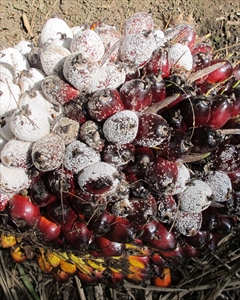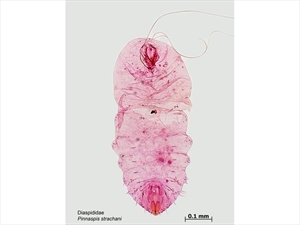Lesser snow scale, hibiscus snow scale
Pacific Pests, Pathogens, Weeds & Pesticides - Online edition
Pacific Pests, Pathogens, Weeds & Pesticides
Hibiscus lesser snow scale (346)
Pinnaspis strachani
Asia, Africa, North, South and Central America, Europe (glasshouses), the Caribbean, Oceania. It is recorded from Cook Islands, Fij1, French Polynesia, Kiribati, Niue, Papua New Guinea, Samoa, Solomon Islands, Tokelau, Tonga, Tuvalu, and Vanuatu.
Wide. Many shrubs, trees and ornamentals are hosts, and weeds too. The most commonly infested are asparagus, avocado, capsicum, cassava, citrus, coconut, Cordyline, cotton, hibiscus, mango, oil palm, and yam.
An armoured scale which produces a cover or 'armour' above its body for protection. It often occurs in large numbers (Photos 1&2), sucking the sap from leaves, stems and fruit, weakening plants and causing distortions. The appearance of infested fruit affects market sales.
Eggs are laid under the armour of the female; they hatch producing crawlers, which leave the armour and as they have legs move to other parts of the plant. After a short time, they settle, feed, build the armour, and go through several moults before becoming adult (Photo 3). The armour of the adult female is 1.5-2.5 mm long, mussel-shaped, slightly curved, and white to grey. That of the male is shorted, elongate, narrow, snow-white, with three longitudinal ridges. The males are more common and noticeable than the females. After several more moults than the female, the males become tiny, winged insects with eyes and legs, but no mouthparts. Their task is to find females and mate. The life cycle is about 30 days.
Spread occurs when crawlers disperse over short distances, or longer when carried by wind currents, vehicles, animals, birds, or on clothing. All stages are spread in the horticultural trade of plants or plant parts.
Occasionally, a pest of citrus, hibiscus, coconut, mango, but usually not serious in Pacific countries, as it is under biological control.
Look for the characteristic shape of the armour of both sexes. Look for the yellowish-brown spot at the narrow end of the female scale that is the remains of the moulted skins. As with other armour scales, identification is done after the insects are slide-mounted and examined by a specialist.
NATURAL ENEMIES
There are several predators and parasitoids used in biological control of the lesser snow scale. In Hawaii, for instance, the ladybird beetle, Telsimia, was introduced and has become established, and the parasitoid wasp, Aspidiotiphagus cinnus, has also been used to bring the scale under control. Other parasitoids used in biological control programs are Aphytis diaspodis and Arrhenophagus chionaspidus. In Fiji, it is heavily parasitised by Aphytis chrysomphali and Aspidiotiphagus citrinus, which were introduced from French Polynesia in 1920.
The management of the lesser snow scale is based on biological control, and in some countries the use of insecticides.
CULTURAL CONTROL
- Check that nursery stock is free from scale; if present, prune infested parts, and spray with insecticides (see below).
- Make sure there is adequate space between plants in the field so that foliage does not touch, which would otherwise assist the spread by crawlers.
CHEMICAL CONTROL
Crawlers are more susceptible to insecticides than other stages, but they very small and difficult to see. There are also overlapping generations, so adults are always present, and this means that several applications of chemicals are necessary to obtain control. And adults are difficult to kill because of their protective scales. (Note dimethoate, once recommended in Pacific island countries, is under suspension in Australia for use on many crops.)
- Use lime sulphur (polysulphide sulphur) or wettable sulphur; leave at least 30 days between spraying lime sulphur and sprays of oil. Take care to following manufactures instructions as sulphur can burn the leaves. Note applications of sulphur will most likely affect parasitoid wasps.
- Alternatively, use white oil (made from vegetable oils), soap solution, or horticultural oil (made from petroleum) (see Fact Sheet no. 56).
-
White oil:
- 3 tablespoons (1/3 cup) cooking oil in 4 litres water
- ½ teaspoon pure hand soap, not detergent
- Shake well and use.
- Soap:
- Use soap (pure soap, not detergent):
- 5 tablespoons of soap in 4 litres water.
-
- Commercial horticultural oil can also be used. White oil, soap and horticultural oil sprays work by blocking the breathing holes of insects causing suffocation and death. Spray the undersides of leaves; the oils must contact the insects. A second application of soap or oils may be necessary after 3-4 weeks.
- The addition of malathion is useful against scales insects, but it is likely to kill natural enemies. Malathion should be avoided, if possible.
- Use synthetic pyrethroid insecticides; they are likely to be effective against the crawlers - crawlers are the active nymphs that spread infestations, but they are difficult to see as they are so small. Synthetic pyrethroids are likely to kill natural enemies. They should be avoided, if possible.
____________________
When using a pesticide, always wear protective clothing and follow the instructions on the product label, such as dosage, timing of application, and pre-harvest interval. Recommendations will vary with the crop and system of cultivation. Expert advice on the most appropriate pesticide to use should always be sought from local agricultural authorities.
- AUTHOR Grahame Jackson
1Information from Swaine G (1971) Agricultural Zoology in Fiji. Her Majesty's Stationery Office. London; and CABI (2008) Pinnaspis strachani (lesser snow scale) Crop Protection Compendium. (https://www.cabi.org/cpc/datasheet/41334); and from Pinnaspis strachani (Cooley) (1992) Crop Knowledge Master University of Hawaii, Manoa, College of Tropical Agriculture and Human Resources. (http://www.extento.hawaii.edu/kbase/crop/Type/p_strach.htm). Photo 2 MAF Plant Health & Environment Laboratory (2011) Lesser Snow Scale (Pinnaspis strachani): PaDIL - (http://www.padil.gov.au).
Produced with support from the Australian Centre for International Agricultural Research under project PC/2010/090: Strengthening integrated crop management research in the Pacific Islands in support of sustainable intensification of high-value crop production, implemented by the University of Queensland and the Secretariat of the Pacific Community.






